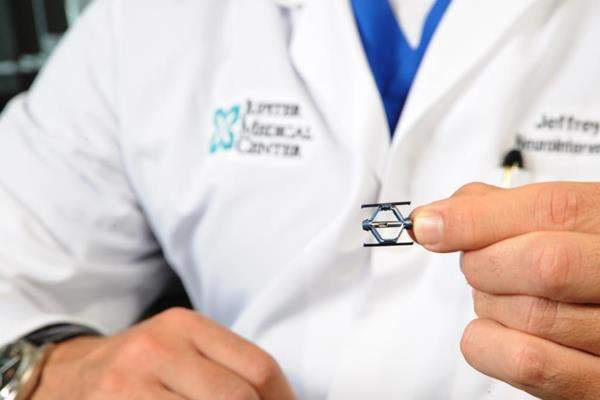
The innovative device stabilizes and restores damaged vertebra to their original shape and height in a minimally invasive procedure that takes about 30 minutes.
Jupiter Medical Center president and CEO Don McKenna said: “We take pride in offering the most advanced treatment options available. With this new technology, we are establishing Jupiter Medical Center as a leader in spine care not just locally, but nationally.”
Approved by the US Food and Drug Administration (FDA) in September, SpineJack has been commercially available in Europe since 2008, with more than 70,000 units implanted worldwide. It is produced domestically by the Stryker medical technology company.
Neuroendovascular Surgery medical director and Jupiter Medical Center the Stroke Program co-medical director Jeffrey Miller said: “This is a revolutionary advancement for treating many patients suffering from acute osteoporotic vertebral compression fractures.
“We know from its success in Europe over the last decade that it significantly improves the patient’s quality of life almost immediately.”
Jupiter Medical Center Imaging medical director Lee A. Fox said: “SpineJack is part of the expanding array of treatment options available in Jupiter Medical Center’s Interventional Radiology Program.
“Our program offers a full scope of advanced diagnostic procedures and minimally invasive therapies, and we are delighted to bring this new treatment option to our patients.”
Dr. Miller performed Jupiter Medical Center’s first SpineJack on Nov. 6. His patient, 75-year-old Robert Fischer of North Palm Beach, is pleased with the outcome. “It’s only been three weeks and I feel close to perfect – I’d say 95%,” said Fischer, who was diagnosed with osteoporosis earlier this year after he began suffering debilitating back pain.
VCFs are the most common medical condition experienced by those with osteoporosis or low bone mass. VCFs occur when the vertebral body in the spine collapses, which can lead to severe pain, spinal deformity and loss of height. The fractures more commonly occur in the middle (thoracic) and lower (lumbar) portions of the spine. While osteoporosis is the most common cause, these fractures may also be caused by trauma or metastatic tumors. The lifetime risk of osteoporotic fracture for those older than 50 years of age is one in two for women and one in four for men.
Miller said: “SpineJack treats back pain by targeting the cause and, as a result, it reduces the need for long-term use of pain medication.
“In addition to enhancing our patients’ quality of life, this procedure could have a significant impact in the effort to combat opioid addiction.”
For decades the only nonsurgical treatments for VCFs were bed rest, bracing (which limits mobility) and pain medication. Vertebroplasty has been used since the early 1990s and more recently kyphoplasty, which has become a mainstay in the treatment of VCFs. In vertebroplasty, bone cement is injected directly into the fractured vertebra, where it quickly hardens and acts like an internal cast. In kyphoplasty, a balloon is inserted into the fracture to expand the space before the cement is added. Neither procedure restores the vertebral body to its full height.
SpineJack was invented by a French physician whose inspiration was a scissor jack, the diamond-shaped car jack that is commonly used to lift a vehicle when changing a flat tire. Instead of a kyphoplasty balloon, the procedure utilizes a titanium implant that resembles a tiny scissor jack, which is deployed into the fractured vertebral body. Once in place, the SpineJack is expanded to lift the compressed vertebra and restore it to its normal height. Two implants are used in the procedure, one on each side of the vertebral body. They are locked into the desired expanded position and bone cement is then injected to stabilize the vertebra. The implant becomes encapsulated with bone cement resulting in pain relief for the patient.
Fischer proved to be the ideal patient to undergo the first SpineJack at Jupiter Medical Center. In August, while spending the summer in Rhode Island, he underwent a kyphoplasty procedure to treat a VCF in his upper back. While wintering in South Florida just a few months later, he suffered a second VCF during a round of golf—this time in his lower back. His primary care physician referred him to Dr. Miller, who thought he would be a good candidate for SpineJack.
He said: “My recovery was much quicker. With (kyphoplasty), that recovery took about 10 weeks before I felt as good as SpineJack feels now, just three weeks later. I would definitely recommend it.”
Source: Company Press Release





